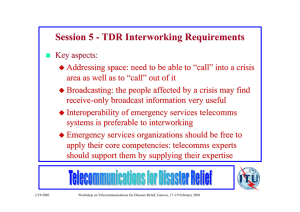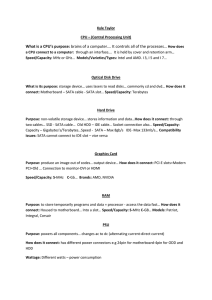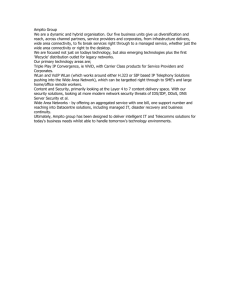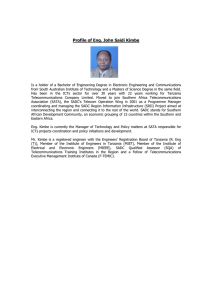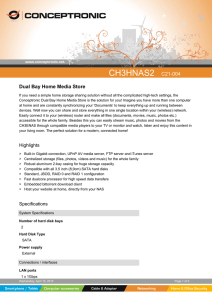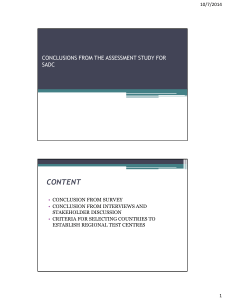SATA’S ROLE IN STANDARDS ____________________________________________ ______________________
advertisement
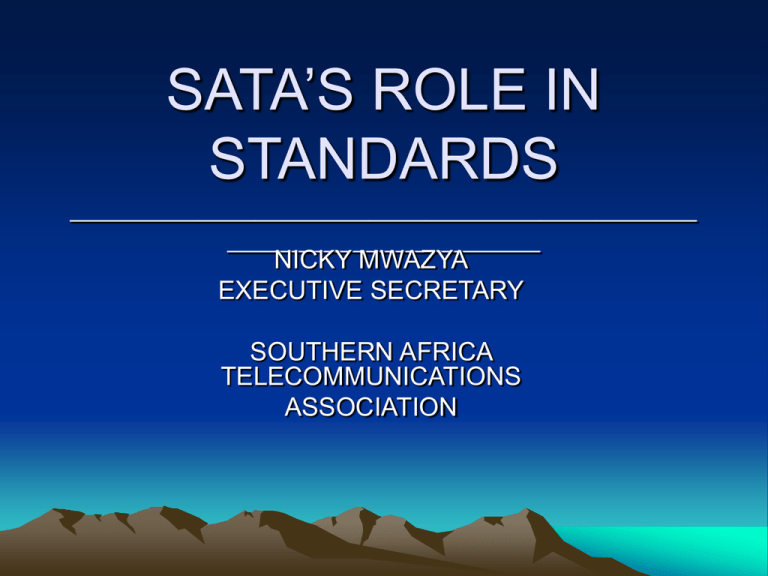
SATA’S ROLE IN STANDARDS ____________________________________________ ______________________ NICKY MWAZYA EXECUTIVE SECRETARY SOUTHERN AFRICA TELECOMMUNICATIONS ASSOCIATION OVERVIEW • • • • • • • • Historical Backgound Initial Intent and Driving Factors SADC Objectives/Protocol Telecomms Policy Establishment of SATA SATA Objectives SATA Working Committees Conclusion HISTORICAL BACKGROUND • SADC TREATY Articles 22 & 23 of the provides for Member States to conclude a protocol to expand and deepen their corporation in the areas of INFRASTRUCTURE and SERVICES • Gave way to the signing of the PROTOCOL On Transport, Communications and Meteorology and the establishment of SATCC-TU. INITIAL INTENT To establish VIABLE and SUSTAINABLE transport, communications and meteorology within the SADC region MAJOR DRIVING FACTORS Transport, Communications and meteorology functions have a regional and global character and are a PREREQUISITE for the promotion of economic growth and development, and consequently, the quality of life and social interaction of all their citizens within the region, continentally and internationally MAJOR DRIVING FACTORS Members’ Rights and Obligations under the regional and international agreements must be built collectively to promote CONVERGENCE and COMPATIBILITY with regional and global trends, while a unified approach is adopted to common issues of common interest MAJOR DRIVING FACTORS Transport, Communications and Meteorology INFRASTRUCTURE, EQUIPMENT, HUMAN RESOURCES,TECHNOLOGY, and SERVICES represent the collective patrimony of the region and comprise assets of significant strategic value TELECOMMS OBJECTIVES Member States agree to take advantage of international technological developments and to develop national telecomms networks for the provisions of reliable, effective and affordable telecomms services in order to: FIRST OBJECTIVE Ensure adequate high quality and efficient services responsive to the diverse needs of commerce and industry in support of regional social and economic growth; SECOND OBJECTIVE Achieve regional universal service with regard to telecomms services and regional universal access to advanced information services THIRD OBJECTIVE Enhance service interconnectivity in the region and globally. TELECOMMS POLICY • In order to attain telecomms objectives, Member States agree to develop a HARMONIZED regional telecomms policy. • HARMONIZATION: The dynamic process of establishing mutually complementary policies, legislation, rules, STANDARDS, PRACTICES or SYSTEMS. ESTABLISHMENT OF SATA Southern Africa Telecommunications Association Constitution was amended on 8th December 1999 in pursuit of the SADC Treaty and SADC Protocol on Transport, Communications and Meteorology to serve as a regional platform to face new challenges and the opportunities in the everchanging telecomms environment. GENERAL OBJECTIVES OF SATA • Promote the interests of its members in the changing global and regional regulatory and business environment ; • Be fully representative of public telecomms operators and service providers in the SADC region; • Encourage technological and business co-operation amongst Members; GENERAL OBJECTIVES CONT’D • Facilitate beneficial access to innovative technologies for members; and • Encourage co-operation amongst members in training and human resource development and capacity building. SPECIFIC OBJECTIVES • Inform and sensitize its members, international and regional organizations, governments and the public about ongoing developments and areas of concern in telecomms in the region. • Formulate common positions, views and responses on issues affecting members at national, regional and international level. SPECIFIC OBJECTIVES CONT’D • Harmonize and promote the adoption of regionwide standards for network characteristics, services, equipment and other technical issues of collective interest. • Coordinate members’ views on the use of the radio frequency spectrum and submit the same to TRASA for action. • SATA is a Consultative Member of the SATCC Telecomms Committee. WORKING COMMITTEES 1. Policy and Strategy Committee - for policy issues 2. Technology and Infrastructure Committee - for technical issues SATA has various sub-committees under the above two committees . POLICY & STRATEGY COM’ SUB-COMMITEES • • • • • Human Resource Development Strategic Partnerships and Alliances Operational Performance Business Development Impact of Global Regulation TECH & INFRASTRACTURE SUB-COMMITTEES • • • • • New Technology and services Connectivity and Inter-operability Implementation of regional networks Operating Standards Radio frequency management BEST BUSINESS PRACTICE • • • • • Staff to DEL ratio Faults clearance rates: 24,48 & 72 Hours Answer Ceasure Ratio (ASR) Percentage of digitalization: Swg & Txn Faults per 100 connections BEST BUSINESS PRACTICE • Disputed bills per 10,000 bills sent22 • Customer complaints per 1,000 connections • Speed of provision of service • Average length of waiting time for service • Customer fidelity. SATA - MEMBERSHIP Membership is open to all telecom service providers who own a public network. CONCLUSION
